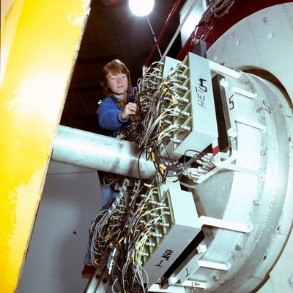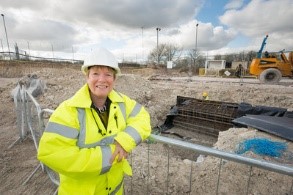As well as being an integral part of ISIS, the facility is just as much a part of Deputy Director of Operations, Zoë Bowden; “It has been said that, if you cut me in half you will find, 'ISIS' running all the way through like a stick of seaside rock," she says.
Her ISIS journey began when leaving school; “I just wanted a career in science," Zoë explains; “so I applied to be an Assistant Scientific Officer. This was a scheme similar to modern day apprenticeships, comprised of a cohort who were 'bid for' by the various departments."
Joining the Rutherford Appleton Laboratory in 1979, before the construction of ISIS, Zoë was chosen to work in the fledgling Neutron Beams Research Unit, developing instrumentation for the Harwell linear accelerator, which was the first accelerator-driven neutron source in the UK.
 During the construction, she was part of the team that installed and commissioned the IRS spectrometer and the LAD diffractometer - both of which have been adapted over the years into instruments that operate today. Her work involved a range of equipment including detectors, choppers, sample environment and data reduction software.
During the construction, she was part of the team that installed and commissioned the IRS spectrometer and the LAD diffractometer - both of which have been adapted over the years into instruments that operate today. Her work involved a range of equipment including detectors, choppers, sample environment and data reduction software.
“Because the staff numbers were much lower than they are today, everyone worked on everything," says Zoë; “I gained a very wide grounding in neutron instrumentation, which has proved hugely beneficial throughout my career."
Left: Zoë Bowden in 1986, working on the HET instrument.
As ISIS prepared to go into operation in 1984, Zoë worked on the build of the High Energy Transfer (HET) instrument, and became one of the first instrument scientists. “The role of instrument scientist was very different back then," Zoë says. “At that time the user community was made up of academics who knew neutron techniques inside out, and shaped their research around them, with a strong emphasis on physics."
“There's been a huge shift since then, to the current model, where our instrument scientists work collaboratively with the user community, helping them include neutron techniques as part of a wider portfolio, covering a huge range of science."
“Everyone needs a Zoë!" says Andrew Taylor, former Director of STFC's National Laboratories, who has worked with Zoë since her first day at the laboratory. “Zoë Bowden has been a valued colleague from the early days of the ISIS facility – her first assignment in the detector group, through developing HET into an instrument capable of delivering world leading science, to helping create and operate the unique facility that ISIS is today."
As the facility grew and Zoë's career developed, she held various scientific and technical posts across neutron instrumentation and sample environment, taking on increased responsibilities and becoming group leader of the User Support Group, covering much of the experimental operation.
“I always thought it was really important to recognise the roles of engineers and technicians," she says; “These groups are vital in enabling the research that the facility does and so, to do the best science, we need not only the best scientists but the best engineers, the best technicians, and the best software developers."
 In 2007, Zoë became Division Head of the newly formed Experimental Operations Division, championing improvements in operational health and safety as well as the expansion of the materials characterisation and deuteration laboratories. She became ISIS Facility Head of Operations and Deputy Director in 2014.
In 2007, Zoë became Division Head of the newly formed Experimental Operations Division, championing improvements in operational health and safety as well as the expansion of the materials characterisation and deuteration laboratories. She became ISIS Facility Head of Operations and Deputy Director in 2014.
“I really enjoy this role, because of the opportunity to use my expertise across the whole of ISIS. I can encourage best practice and facilitate innovation, working to improve the use of facility and its resources to maximise the science we deliver."
Right: Zoë on the construction site of the new R106 building, currently used for developing the UK instruments for the European Spallation Source.
Zoë is also a strong supporter of the STFC's mentoring programme, and sees mentoring as integral to her role; “I think as a leader it's important to ensure all members of your team reach their potential," she says. “I have benefited from mentoring throughout my career from people such as Andrew Taylor and Uschi Steigenberger and it's important to continue that practice for the next generation."
One member of staff who has benefitted from her insight is Victoria Garcia Sakai, who leads the Molecular Spectroscopy group at ISIS, who says, “"When I think of Zoë, the following phrases come to mind: resilient, strong, supportive, good listener, a do-er and a people person. Zoe's career achievements certainly showcase that 'you can do it' and as such she is a great female role model in the scientific world. On a personal note, she has been a pillar of support through challenging times and always provided me with good advice, making me look at things from as many points of view as possible. I look forward to continue to learn from her for many years to come."
Previous Director of STFC's National Labs, Andrew Taylor, agrees with this assessment, “Zoë is both a people person, and a pragmatic deliverer – the go-to person to get things done. The focussed pragmatic approach she has had throughout her career makes her an invaluable asset to STFC leadership and increasingly on the international stage."
There are still things Zoë would like to change; “I do feel that the organisation needs more diversity, particularly in senior management," she says. “I don't think there are the same barriers to women as there were when I started out, but there is still a tendency to recruit people who 'look like us,' and that needs to change."
There are significant developments underway to secure the facility for decades to come, with major projects such as the Endeavour instrument upgrade programme and scoping out the options for the next generation of the facility, ISIS-II. The greatest challenge of all is likely to be learning how to run large science facilities like ISIS in a sustainable way.
“I've seen a huge amount of change during my career at ISIS - we have constantly striven to maximize our potential and to keep the facility at the forefront of materials research. The exciting challenge is to do that for decades to come."
